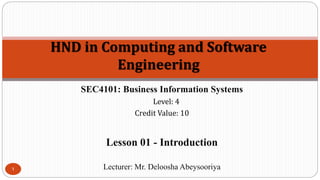The document provides an introduction to a unit on business information systems. It outlines the unit aim, which is to introduce learners to different information systems available and how they can benefit business organizations. The unit learning outcomes include being able to identify the information needs of organizations and their departments. It then lists several reference materials and outlines the assessment strategy, which includes a group presentation and group assignment. Finally, it begins covering the first learning outcome about identifying information needs by outlining topics such as the definition of a business, business objectives, and the relationship between organizations and information technology.



![Reference Materials
4
• BEYNON-DAVIES, P. 2013. Business information systems. 2nd ed. Basingstoke:
Palgrave Macmillan
• BOCIJ, P., GREASLEY, A. and HICKIE, S., 2015. Business information systems
technology, development and management for the e-business. 5th ed. Harlow: Pearson
Education
• Chris-kimble.com. (2015). Different Types of Information System and the Pyramid
Model. [online] Available at: http://www.chris-
kimble.com/Courses/World_Med_MBA/Types-of-Information-System.html [Accessed 4
June. 2019]
• Executive Leadership Series) (Wiley, 2010) ISBN-10: 0470625740
• Gray, J. and Reuter, A. (1995). Transaction processing. San Francisco, Calif.: Morgan
Kaufmann
• LAUDON K. and LAUDON J., 2014. Management information systems managing the
digital firm. 13th ed. Boston: Pearson Higher Education. (Global edition)](https://image.slidesharecdn.com/lecturenotesformat15d78629f3bbda-220729113606-2543c108/85/lecturenotesformat1_5d78629f3bbda_-pptx-4-320.jpg)























































































